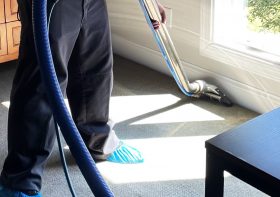Body hair helps animals stay clean – and could inspire self-cleaning technologies

Nature has long been a source of inspiration for human innovation, offering solutions to complex problems through millions of years of evolution. Among the myriad adaptations found in the animal kingdom, body hair serves a crucial role beyond insulation and protection—it aids in self-cleaning. This seemingly simple feature has caught the attention of scientists and engineers, leading to the development of self-cleaning technologies that mimic nature’s elegant solutions. In this exploration, we delve into the mechanisms behind how body hair helps animals stay clean and how these insights are shaping the future of self-cleaning technologies.
The Role of Body Hair in Animal Hygiene:
Body hair, or fur, is a common feature among mammals, serving various functions such as insulation, camouflage, and sensory perception. However, one of its lesser-known functions is its role in maintaining cleanliness. Animals with fur, such as cats, dogs, and certain rodents, exhibit behaviors like grooming to remove dirt, debris, and parasites from their fur. The structure of their fur plays a pivotal role in this self-cleaning process.
The Structure of Fur:
Fur consists of multiple layers, each with unique properties contributing to its self-cleaning ability. At a microscopic level, the outermost layer of fur is composed of overlapping scales or ridges, creating a textured surface. This structure minimizes the contact area between dirt particles and the fur, making it difficult for contaminants to adhere. Additionally, the oils produced by the skin of mammals provide a hydrophobic coating, further repelling water and preventing wetting of the fur.
Furthermore, the spacing and orientation of fur fibers influence the ease of cleaning. Animals with dense fur, like otters, possess a network of fine hairs that trap air bubbles, creating a waterproof barrier and facilitating efficient cleaning by shedding water and contaminants. Additionally, the directional arrangement of fur fibers aids in channeling water away from the skin during grooming, promoting drying and preventing the growth of microorganisms.
Grooming Behavior:
Animals exhibit grooming behavior through licking, scratching, or rubbing, using their tongues, teeth, or paws to remove foreign particles from their fur. This grooming action, often performed meticulously and instinctively, helps to dislodge dirt and distribute natural oils evenly across the fur, maintaining its integrity and hydrophobic properties. Furthermore, grooming stimulates blood circulation and promotes the secretion of oils from specialized glands, enhancing fur cleanliness and health.
Inspiration for Self-Cleaning Technologies:
The remarkable self-cleaning capabilities observed in animals have inspired researchers to develop innovative technologies capable of mimicking nature’s designs. By understanding the principles underlying fur structure and grooming behavior, scientists aim to create surfaces and materials with self-cleaning properties, applicable across various fields including manufacturing, healthcare, and environmental conservation.
Lotus Effect:
One of the most renowned examples of biomimicry in self-cleaning technologies is the Lotus Effect, inspired by the water-repellent properties of lotus leaves. The unique microstructure of lotus leaves, characterized by nanoscale bumps and wax-like coatings, minimizes contact between water droplets and the leaf surface, causing water to bead up and roll off, carrying dirt and contaminants with it. This phenomenon has been replicated in engineered surfaces, leading to the development of self-cleaning coatings for buildings, textiles, and automotive surfaces.
Nanostructured Surfaces:
Building upon the principles of the Lotus Effect, researchers have explored nanostructured surfaces that mimic the textured properties of animal fur. By engineering surfaces with hierarchical structures resembling fur ridges and scales, scientists have achieved enhanced water repellency and self-cleaning capabilities. These surfaces find applications in anti-fouling coatings for ships, medical devices, and electronic displays, where the prevention of contamination and biofouling is critical.
Dynamic Surface Coatings:
In addition to static surfaces, researchers are developing dynamic coatings capable of self-regeneration and continuous cleaning, inspired by the regenerative properties of animal fur. By incorporating stimuli-responsive polymers or microcapsules containing cleaning agents, these coatings can autonomously repair surface damage and remove contaminants upon activation, offering long-lasting protection and maintenance-free operation in harsh environments.
Conclusion:
The study of body hair in animals has unveiled nature’s ingenious solutions for maintaining cleanliness, serving as a blueprint for the development of self-cleaning technologies. By emulating the structural features and grooming behaviors observed in nature, scientists and engineers are creating innovative materials and surfaces with remarkable self-cleaning properties. As these technologies continue to evolve, they hold the promise of revolutionizing diverse industries and addressing pressing challenges related to hygiene, sustainability, and resource efficiency. Nature, once again, proves to be a boundless source of inspiration, guiding humanity towards a cleaner and more sustainable future.




Leave a Reply